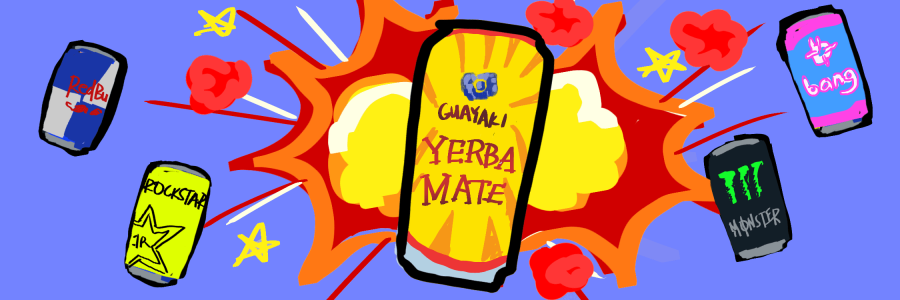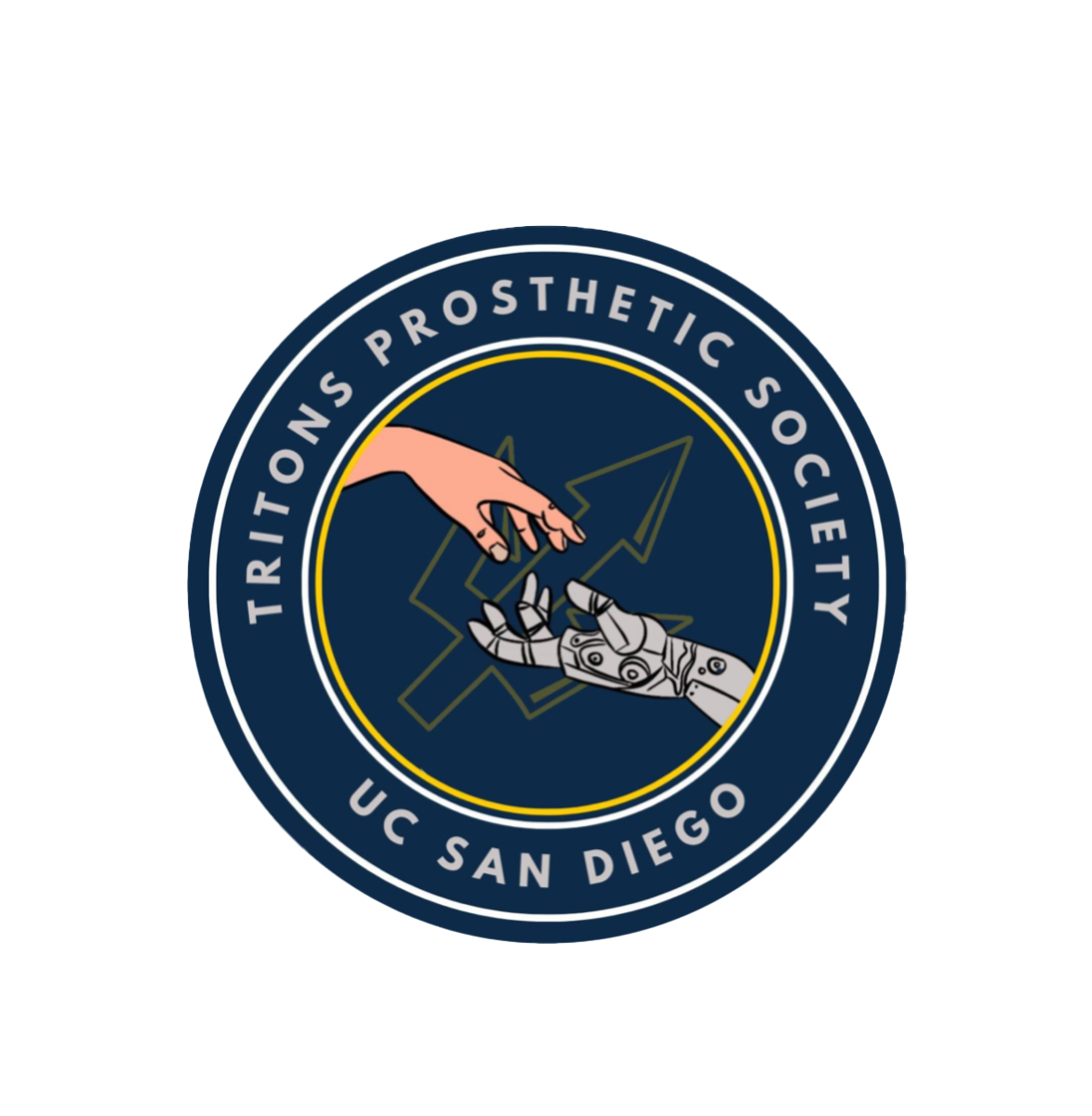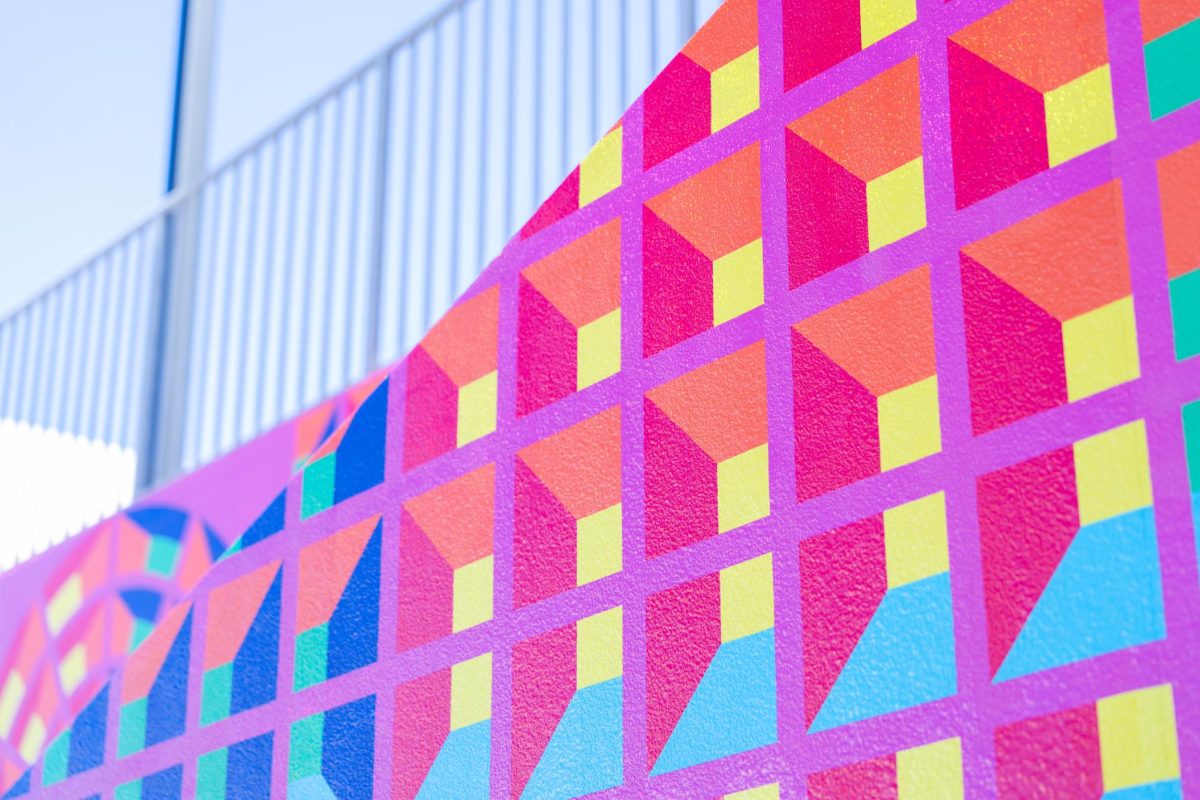Students are drinking yerba mate to stay up for midterms and finals. Its popularity continues to rise and points to college students looking for other forms of caffeine.
Students have a tendency to cram before a midterm or type up an essay the night before it’s due. Caffeine is the fuel for these late-night endeavors and academic binges. Students typically turn to a cup of coffee, but now, walking into any library or study room on campus, one is likely to see students holding an iconic yellow can or colored bottle. There is a challenger to coffee’s throne developing in the caffeine industry: yerba mate.
Yerba mate is a plant that has caffeine and is used to create caffeinated drinks. The drink is produced by a process of brewing yerba mate leaves with water and then combining it with juice as an infusion to create a beverage that has a similar consistency to herbal tea. This plant is based in South America and the drink is very popular in the region, specifically in Paraguay, Brazil, Argentina, and Uruguay. Orlando Yerba Mate is one of many companies that uses the name of the drink for a trademark in North America. The product was introduced into North America due to its popularity among caffeine drinkers.
Guayakí, which is not Food and Drug Administration approved due to a lack of research, is one of the largest companies in the yerba mate industry, and it has an established presence on campus. The company has a variety of drinks ranging from a sparkling drink, a drink based on tea and herbs, “Terere” — which is either unsweetened or sweetened, and a drink that is branded as a typical energy drink in a can with a fusion of juice and tea. Yachak, another yerba mate company, entered the market with a drink that is also a juice and tea fusion. Yerbaé, another yerba mate company, has come out with a sparkling yerba mate drink to rival Guayakí’s sparkling drink. Within the most popular brands, there is a trend of featuring one of these three types of yerba mate drinks. All of these drinks stem from the yerba mate plant.
A recent study conducted by Clinical Nutrition, the journal of The European Society for Clinical Nutrition and Metabolism, finds that 92 percent of college students consume caffeine in any form and that the most popular form is coffee. 79 percent of these students use caffeine as a method to stay awake. The study points to the large portion of caffeine consumers that are among college students.
Many students at UC San Diego view yerba mate as an alternative to coffee. One of these students is Thurgood Marshall College junior Joshua Noritake who still drinks a lot of coffee but is turning to yerba mate as an alternative to a typical energy drink.
“I just see [yerba mate] a lot around the stores,” Noritake said. “Also, I see that it is a little better than energy drinks. It doesn’t have taurine or anything like that.”
Taurine increases the amount of lithium in a person’s body and this leads to health issues like poor kidney health. Apart from lacking taurine, yerba mate has no artificial sweeteners in the unsweetened versions and the caffeine comes from a natural source.
Noritake proudly identifies as someone who is hooked on caffeine and consumes it on a daily basis. Although yerba mate isn’t a replacement for coffee in his eyes, he values it as an alternative that he is more comfortable with than other energy drinks. He attributes this uncontested branding as a driving force for its popularity.
“Probably that it is like an energy drink, but it doesn’t have all of the bad stigma connected to energy drinks,” Noritake said. “It still has all of the caffeine, but it is more appealing to college students,”
Word about yerba mate is spreading and it is being talked about in everyday locations. Roger Revelle College sophomore Spencer Rivera heard about the product at a place where more people in San Diego go to.
“I was at the beach on a pretty nice day and some lifeguards were talking about this new drink called yerba mate. It sounded modern and cool,” Rivera said. “The taste was great the first time and it had the right amount of caffeine. The bottle said that it was from Paraguay and that was pretty exotic.”
UCSD’s Housing Dining Hospitality, and markets like Roger’s Market, John’s Market, and Goody’s Market all have yerba mate products in their stores. Other markets on campus that don’t take dining dollars, the General Store Co-op and Sunshine Market among them, have also entered the yerba mate game.
Larry Shadgett has been the manager of Sunshine Market for 10 years. He remembers the early days of yerba mate at UCSD, when Sunshine would “only sell two cases a week.” Guayakí used to have events in which they would give away the product, according to Shadgett. The events helped to establish its presence on campus as an alternative to other energy drinks. Sunshine Market currently carries the Guayakí yerba mate at $2.50 per can, the cheapest price for Guayakí on campus. Additionally, the store has an entire wall in the fridge dedicated to Guayakí products. This wall is usually empty by the end of day until the employees restock. Sunshine Market sells anywhere from 75 to 100 cases of yerba mate a week now and its rise is still a surprise for Shadgett because it didn’t seem to catch on at its beginning. He has vivid memories of it being untouched, but he expects it to rise going forward.
Shadgett’s perspective as a manager of the store shows how sudden the yerba mate craze developed on campus. This generation developed an attachment to the product that allowed for growth to happen suddenly. The curiosity of students is at a high point in college and it leads to an increase in the willingness to try new products. Prachi Shah, an associate professor of pediatrics at the University of Michigan, conducted a study about the effects of curiosity on the human mind and concluded that “the aspect of curiosity most strongly associated with higher academic achievement was the construct of ‘shows eagerness to learn new things.’”
The study demonstrates that the most academically successful people that make it to college are curious. Students come to college with ambitions to discover things both academically and socially. All it takes for a new drink to be established is to align itself with a generation’s curiosity and the word-of-mouth effect is spread to similarly curious students.
In the last year, the results of Guayakí’s marketing campaign have paid huge dividends as highlighted in an article by BevNET Magazine, “According to market research group IRI, the company saw bottled and canned tea sales rise 17.9% through August 11, climbing to over $41.7 million.” Their popularity has led to competitors rising to claim a piece of the pie. Yachak was one of the sponsors of last year’s Sun God Festival and was giving out free drinks at the event. The college student consumer is targeted by Yachak due to the potential to have them hooked on its product early on and have a loyal customer. This makes college students the ideal audience to sponsor and brand itself to so it can create a generation of loyal consumers.
It hasn’t only been UCSD that has felt the marketing from yerba mate companies to college students. Yerba mate has developed in other schools as well. UC Santa Barbara is another example of how students are gravitating to the marketing style as noted in an article from The Bottom Line, “To accommodate the crazed fans, the Arbor ‘gets a shipment of about 150 cases [1800 individual bottles] every week’ to completely replenish their stock.”
This trend of marketing directly to college students combined with the constant stream of ads highlights the increasing effectiveness that companies have by constantly displaying their products. Both trends wear out the new consumer and make them either buy the advertised item or, like in yerba mate’s case, hook students on a drink that the student relies on when a long night is ahead.
A group of students here at UCSD figured that they could make a cleaner version of yerba mate that could further expand upon the growth that was happening. Mi Mate is a company that began due to this group of students banding together to form a refined venture in the yerba mate industry.
The founders of Mi Mate are John Muir College senior Eddie Muallem, Sixth College senior Yaniv Shemesh, and Sixth College alumni Alan Luna who graduated last year. All three members jumped at the opportunity to create a product centered around “the idea of creating a healthier yerba brand that could stand as a challenge to conventional canned yerba, loaded as they are with sugar, preservatives, and artificial flavors,” Luna told the UCSD Guardian.
Each member studied different academic areas, which they use to help the business grow. Shemesh studies economics and is in charge of setting up connections to international supply. Luna majors in art studio and art history and is in charge of the creative and social side of the company. Muallem does the financial leg work for Mi Mate. As a whole, they use their skill sets gained from UCSD to handle different parts of the company.
They are trying to tackle the yerba mate giants with a product that lacks the artificial sweeteners that make the good taste, but still has the caffeine that made it so popular. The three students ventured to Paraguay in order to further research what the product was and how it was grown.
“We wanted to properly understand the history and culture of yerba mate, so we scraped together some money and journeyed down to Paraguay: a vibrant yet obscure nation in the heartland of South America, and the home of the yerba mate tradition,” Luna said. “The three of us spent three weeks on the road, from the bustling streets of Asunción to the preternatural quiet of the Alto Paraná, exploring and learning about yerba culture from the wonderfully kind people we encountered.”
This yerba culture that he mentions is how highly the people in South America regard the beverage as a drink that can help maintain good health. The high regard for the drink leads to it being shared among family members and friends.
The students were interested in the unique effect that the caffeine derived from the yerba mate plant had. They found it to be a lot more tempered with a slow rush of energy when compared to coffee or Monster Energy. This kind of drink appeared to once be niche, but over the years its persistent presence on campus has led to its popularity rising significantly.
“Yerba mate is unique in the sense that in spite of having as much caffeine as a coffee or a conventional energy drink, yerba mate is a jitter and crash-free energy experience,” Luna told the UCSD Guardian. “This is thanks to the rich quantities of l-theobromine present in yerba mate, a vasodilator that opens up your arteries and allows your body to absorb the caffeine with ease and grace, unlike the system shock of coffee or energy drinks.”
The product needed to differentiate itself from the other drinks, but Mi Mate is attempting to target the same demographic as most big brands: college students.
“We’re a pretty shoestring operation, so our marketing efforts have been more D.I.Y. and on the ground than anything,” Luna said. “Whether it be our sampling around UCSD or selling products at warehouse punk shows, we think it’s human connection and word of mouth that’s sparked our initial success.”
Mi Mate yerba mate is sold at all markets at UCSD, but the G-Store at the Old Student Center has been selling the product since it was released. Marshall College senior Tal Marom works at the G-Store and says that it started selling the drink due to the relationship it has with the founders of Mi Mate. Both of the stores center around being student-run small businesses, and the G-Store and Mi Mate’s main consumers arestudents. He attributed the introduction of Mi Mate and the overall explosion of yerba mate to it being branded as a cleaner form of caffeine consumption that is unsweetened and lacks the potent caffeine rush and crash.
When walking into the G-Store, a sign on the fridge proudly promotes the lowest prices for Mi Mate yerba mate on campus. The efforts to make the product more accessible is the plan that has been used to establish yerba mate in the mainstream. The pattern of marketing that Guayakí, Yachak, and now Mi Mate are using to inject yerba mate into the mainstream stems from a grassroots push to have college students try it. The marketing’s success is based on student bodies being constantly willing to try something new, especially if it’s cheap and has caffeine.
Students’ curious natures allow for new potential trends to be established in the mainstream more often as they supply direct feedback via social media about a product, which can make its market rise rapidly. The current generation of students replaced energy drinks with yerba mate drinks as the alternative to coffee in a similar fashion that streaming music has replaced radio stations. As generations shift, curious people will become attached to alternative ways of doing things, which motivates people to innovate with the hope that the new way will catch on.
Art by Jessica Ni.













